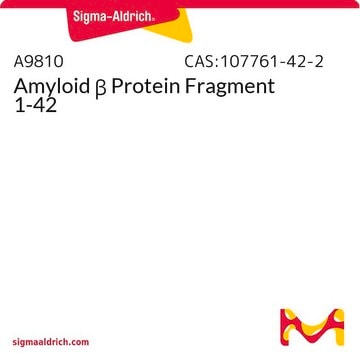G6878
3-Guanidinopropionic acid
≥97.5% (TLC)
Synonym(s):
β-Guanidinopropionic acid
Sign Into View Organizational & Contract Pricing
All Photos(1)
About This Item
Linear Formula:
HN=C(NH2)NHCH2CH2COOH
CAS Number:
Molecular Weight:
131.13
Beilstein:
1705262
EC Number:
MDL number:
UNSPSC Code:
12352209
PubChem Substance ID:
NACRES:
NA.26
Recommended Products
Product Name
3-Guanidinopropionic acid,
Assay
≥97.5% (TLC)
Quality Level
form
powder or crystals
color
white
mp
222 °C (dec.) (lit.)
storage temp.
2-8°C
SMILES string
NC(=N)NCCC(O)=O
InChI
1S/C4H9N3O2/c5-4(6)7-2-1-3(8)9/h1-2H2,(H,8,9)(H4,5,6,7)
InChI key
KMXXSJLYVJEBHI-UHFFFAOYSA-N
Looking for similar products? Visit Product Comparison Guide
Biochem/physiol Actions
β-Guanidinopropionic acid is studied for potential use during protein refolding as an anti-aggregatory molecule similar to L-arginine. β-Guanidinopropionic acid may be used to study its proliferative activity for endothelial cells contributing to wound healing. β-Guanidinopropionic acid is closely related to leptin.
Signal Word
Warning
Hazard Statements
Precautionary Statements
Hazard Classifications
Eye Irrit. 2 - Skin Irrit. 2 - STOT SE 3
Target Organs
Respiratory system
Storage Class Code
11 - Combustible Solids
WGK
WGK 3
Flash Point(F)
Not applicable
Flash Point(C)
Not applicable
Personal Protective Equipment
dust mask type N95 (US), Eyeshields, Gloves
Choose from one of the most recent versions:
Already Own This Product?
Find documentation for the products that you have recently purchased in the Document Library.
Customers Also Viewed
Mary Chebib et al.
Neurochemical research, 34(10), 1704-1711 (2009-04-24)
GABA(C) receptors play a role in myopia, memory-related disorders and circadian rhythms signifying a need to develop potent and selective agents for this class of receptors. Guanidino analogs related to glycine, beta-alanine and taurine were evaluated at human rho(1)GABA(C) receptors
Efraim H Rosenberg et al.
Journal of inherited metabolic disease, 29(2-3), 345-346 (2006-06-10)
In the study reported, we prove that mutations in the SLC6A8 gene are responsible for SLC6A8 deficiency, a cerebral creatine deficiency syndrome (CCDS), since overexpression of the wild-type SLC6A8 open reading frame (ORF) restores the creatine uptake profile in SLC6A8-deficient
A Bexfield et al.
The British journal of dermatology, 162(3), 554-562 (2009-10-06)
Maggot therapy, utilizing the larvae of Lucilia sericata, has been reported to reduce the bacterial load within wounds and also to enhance wound healing. Maggot excretions/secretions (ES) have been shown to have a role in the success of maggot therapy.
Yoshinobu Ohira et al.
Bioscience, biotechnology, and biochemistry, 75(6), 1085-1089 (2011-06-15)
The effects of supplementation with creatine (Cr) and its analog, β-guanidinopropionic acid (β-GPA), on the differentiation of myoblasts and the numbers of nucleoli were studied in C2C12 cells. The cells were cultured in differentiation medium for 4 d. Then Cr
Inge Oudman et al.
PloS one, 8(1), e52879-e52879 (2013-01-18)
Creatine kinase plays a key role in cellular energy transport. The enzyme transfers high-energy phosphoryl groups from mitochondria to subcellular sites of ATP hydrolysis, where it buffers ADP concentration by catalyzing the reversible transfer of the high-energy phosphate moiety (P)
Our team of scientists has experience in all areas of research including Life Science, Material Science, Chemical Synthesis, Chromatography, Analytical and many others.
Contact Technical Service











